Fierce battle for Zhitomir and Berdichev
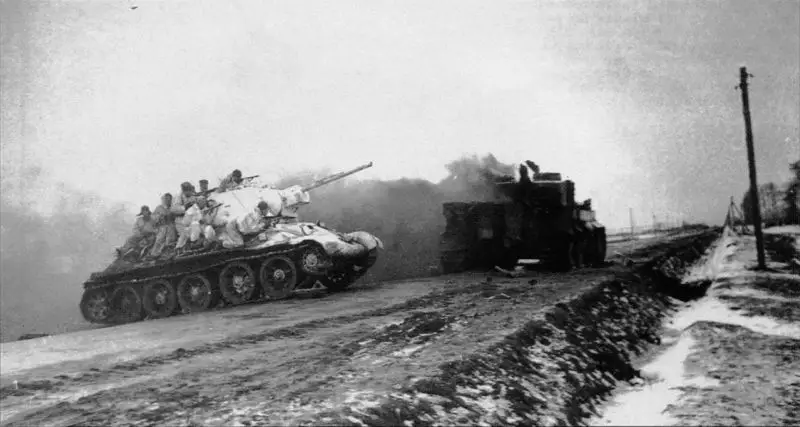
A Soviet T-34 tank with troops crosses the Zhitomir-Berdichev highway. Burning tank Pz. Kpfw. VI "Tiger". 1st Ukrainian Front. January 1944
Plans of the Soviet command
On November 13, 1943, units of the German Army Group South launched a counteroffensive, advancing 40 kilometers. The Nazis recaptured a number of cities, including Zhitomir and Brusilov, but Russian troops managed to defend Kyiv. Fierce fighting continued until December 23 (Kiev operation).
The Soviet Headquarters begins the strategic Dnieper-Carpathian operation with the goal of liberating Right Bank Ukraine (The battle for the liberation of Right Bank Ukraine). The first operation was the Zhytomyr-Berdichevskaya operation. In order to exclude the possibility of a new enemy attack on Kyiv, it was decided to put an end to this possibility once and for all and destroy the German 4th tank the army of General E. Routh, throwing back the remnants of the enemy forces to the Southern Bug.
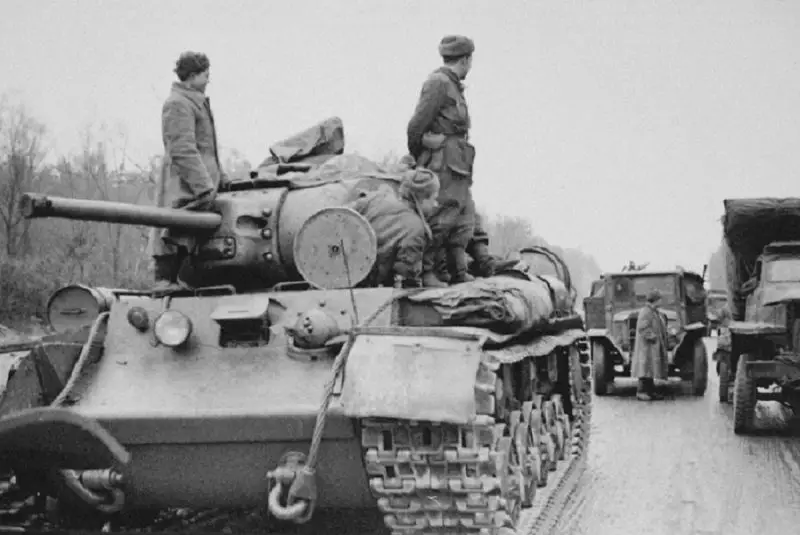
Soviet tankers on the armor of the KV-1S tank of one of the tank regiments of the breakthrough of the 1st Ukrainian Front during a march on the highway near Zhitomir. November 1943
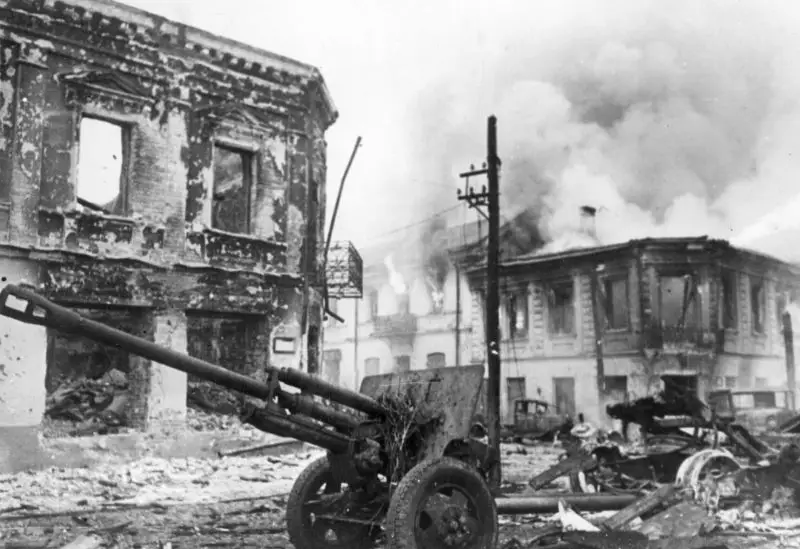
Soviet 76,2 mm ZiS-3 cannon captured by German troops in Zhitomir. The gun was towed by a car, the skeleton of which is visible behind the gun. In the background is another wrecked GAZ-AA car.
Zhitomir was abandoned by Soviet troops under pressure from the German counteroffensive on November 20, 1943 due to the threat of encirclement of the forces of the 60th Army of the 1st Ukrainian Front. November 1941
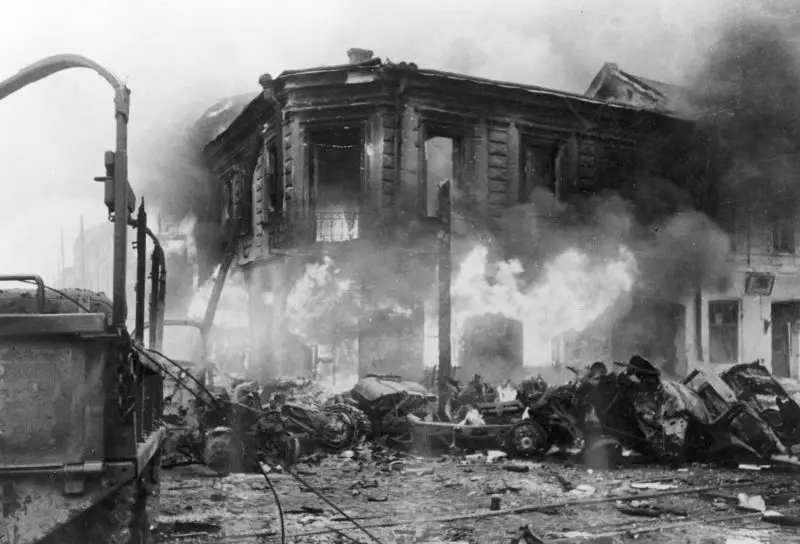
Destroyed Soviet vehicles in Zhitomir captured by German troops. November 1943
However, Vatutin’s 1st Ukrainian Front (1st UV) after heavy November battles could not solve this problem on its own. Therefore, the 1st UV was significantly strengthened. Leselidze's 18th Army, Katukov's 1st Tank Army, as well as the 4th Guards Tank and 25th Tank Corps were transferred to Vatutin's command.
The main attack in the Brusilov area should have been inflicted by units of the 1 Guards Army Grechko, the 18 Th Army and Leselidze, the 38 Th Army of Moskalenko, the 1 Tank Army of Katukov and the 3 of the Guards Tank Army Rybalko. Our troops received the task of destroying the Brusilov grouping of the enemy (4 tank divisions) and go on the line of Lyubar, Vinnitsa and Lipovets.
The 60th Army, with the 4th Guards Tank Corps attached to it, was supposed to defeat enemy troops in the Radomyshl area, reach the line of the Sluch River, then to the Shepetovka, Lyubar sector. The right-flank 13th Army, with the support of the 1st Guards Cavalry Corps and the 25th Tank Corps, advanced on Korosten, Novograd-Volynsky and was tasked with occupying the line of Tonezh, Olevsk and Rogachev.
On the left flank of the 1st UV, the troops of Zhmachenko’s 40th Army, with the 5th Guards Tank Corps and the Czechoslovak Brigade, and Trofimenko’s 27th Army were to strike in the direction of Bila Tserkva and further develop the offensive towards Khristinovka, where they would link up with troops of the 2nd Ukrainian Front and defeat the enemy forces operating south of Kanev.
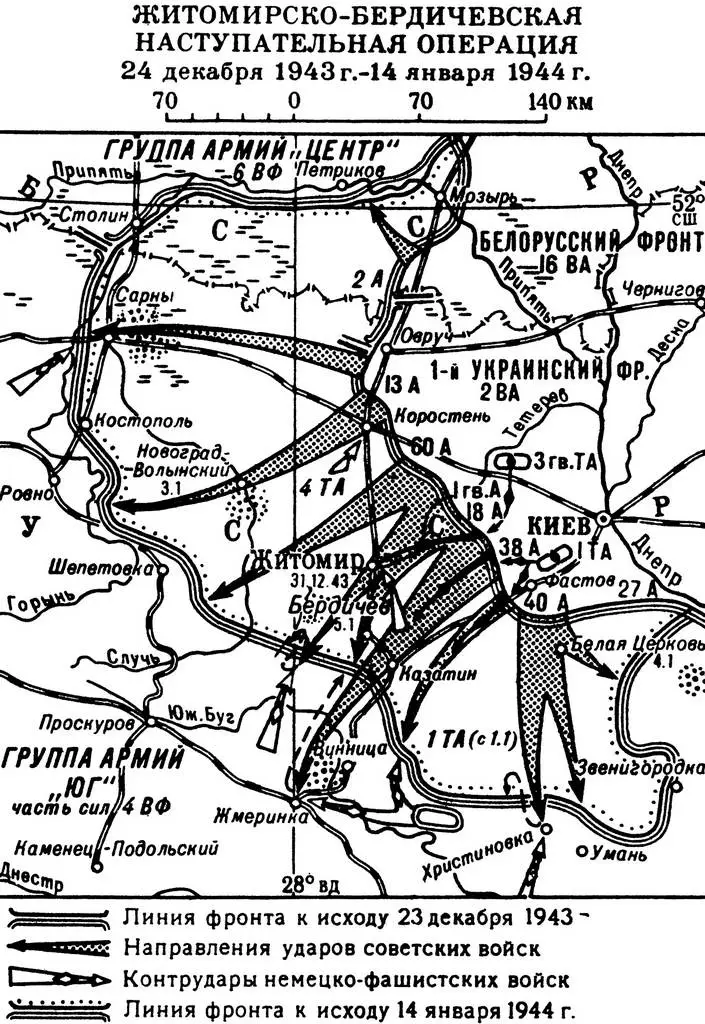
The forces of the parties
At the beginning of the operation, the 1st UV included 7 combined arms armies (1st Guards, 13th, 18th, 27th, 38th, 40th, 60th armies), 2 tank armies (1st I Tank and 3rd Guards Tank Army) and 2nd Air Army, Cavalry Corps and 2 fortified areas.
In total, the 1st UV consisted of 63 rifle, 3 cavalry divisions, two fortified areas, one infantry brigade (Czechoslovak), 6 tank and 2 mechanized corps, 5 separate tank brigades. The Soviet Kiev group consisted of more than 830 thousand soldiers and officers, over 11 thousand guns and mortars (without 50-mm mortars), more than 1 anti-aircraft guns, about 200 rocket artillery systems, over 300 tanks and self-propelled guns and more than 1 aircraft.
The Germans in the 4th Tank Army had more than 570 thousand soldiers, about 7 thousand guns and mortars (without 51-mm mortars), about 1 tanks and self-propelled guns, and up to 200 aircraft.
German divisions were drained of blood by stubborn fighting in November and December 1943, when the Wehrmacht tried to recapture Kyiv and return the Dnieper line. The Nazis did not expect that the Russians would be able to immediately, repelling the Wehrmacht counterattacks, launch a powerful offensive. This predetermined the success of the Red Army.
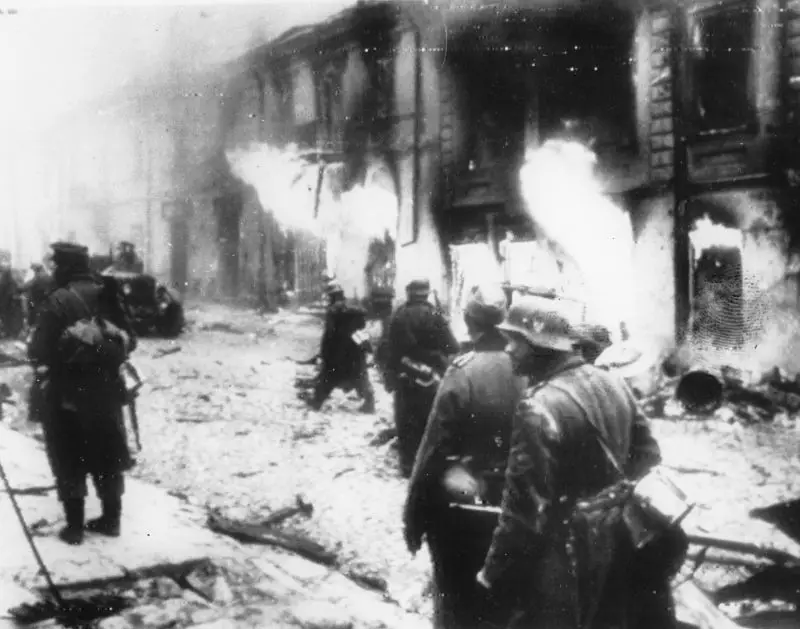
German soldiers on the street burning Zhytomyr. December 1943
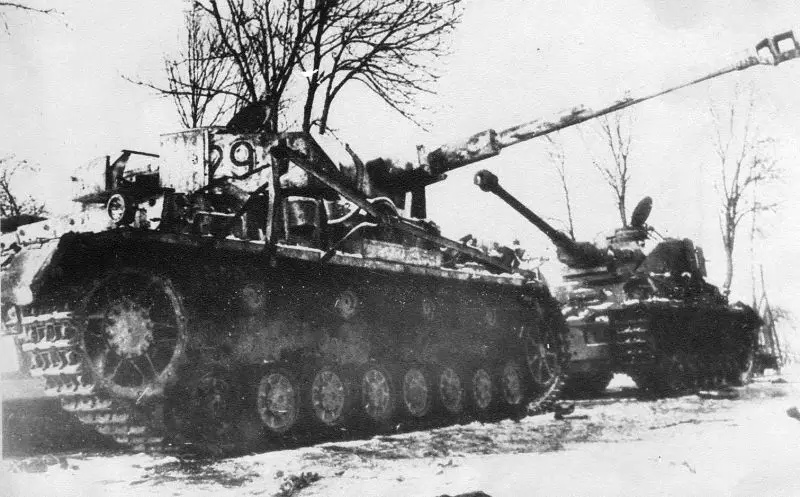
German medium tanks Pz. Kpfw. IV Ausf. G of late series, abandoned in the Zhitomir region. December 1943
Breakthrough enemy defenses
On the morning of December 24, 1943 after the artillery and aviation preparations, the forces of the strike group of the 1st UV went on the offensive. The Soviet artillery strike was very successful.
The commander of the 9th Mechanized Corps, General Konstantin Malygin, recalled:
The commander of the 91st Tank Brigade, Colonel Ivan Yakubovsky (became Marshal of the Soviet Union in 1967) recalled:
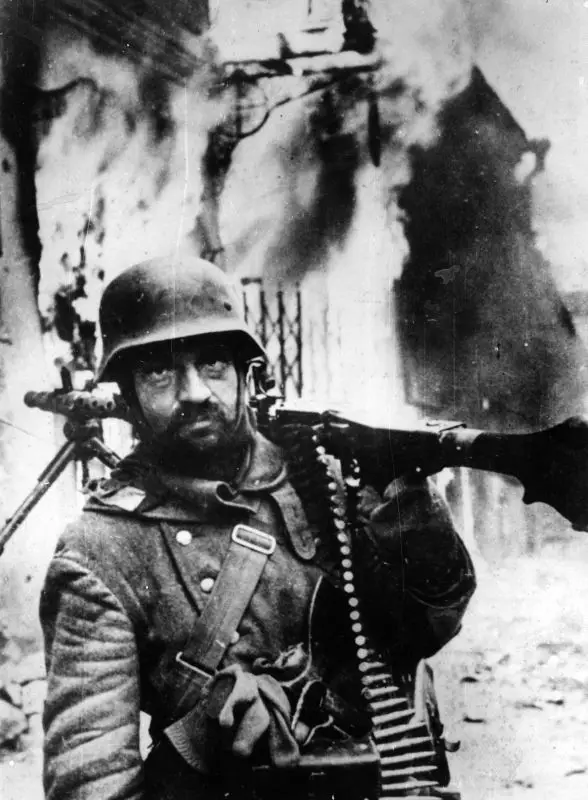
German machine gunner in the center of Zhitomir. December 1943
The commander of the 38th Army, Kirill Moskalenko, recalled:
...the enemy’s fire system at the front line and in the immediate depths was suppressed, and the bulk of the fire weapons were destroyed. The enemy's tactical defense zone in the zone of only the 38th Army was already broken through that day by 20 km along the front and up to 12 km in depth. The 1st Guards and 18th armies under the command of Colonel Generals A.A. Grechko and K.N. Leselidze achieved the same successes.”
At the same time, it was very difficult for the troops. It was wet rain and snow, the roads were bad, and the fields turned into a sea of mud, it was impossible to drive through, even the armored vehicles were skidding and sinking. The water that accumulated in the lowlands spilled into wide reservoirs. The felt boots and overcoats were wet and hung heavy on the Red Army soldiers. It got colder in the evening and at night, the temperature dropped to minus fifteen degrees. On the morning of December 25, there was a sharp warming, the snow quickly began to melt, turning into rushing streams.
Because of the rains and muddy roads, aviation could not fully support the ground forces. Many unpaved airfields are out of order. The mud also interfered with mobile units, which could not develop the maximum speed of movement.
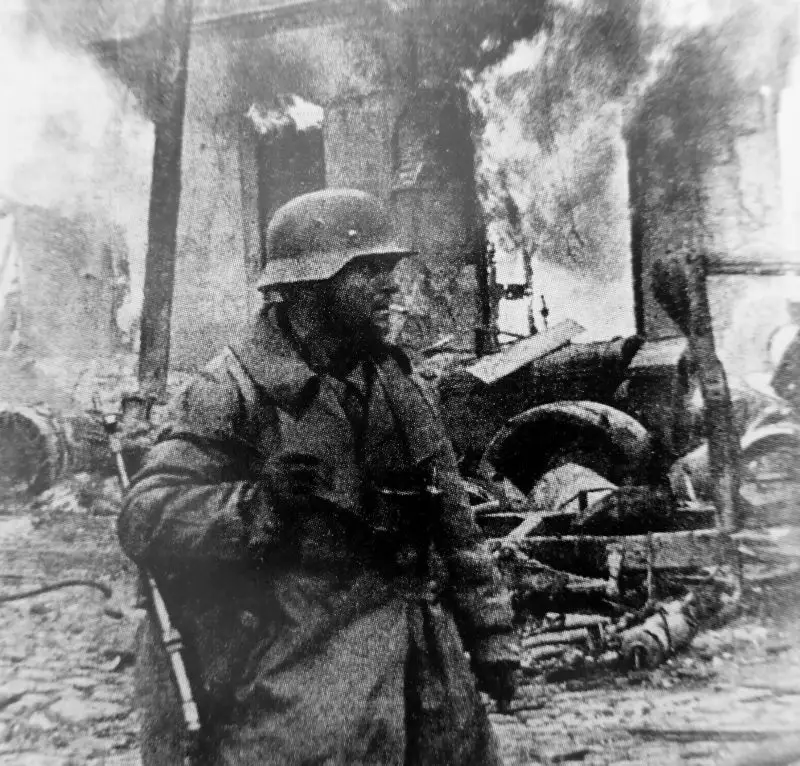
A German soldier near a burning building on Zhitomir Street. December 1943
Tanks are breaking through
On the same day, in the offensive zone of the 18th Army, the 3rd Guards Tank Army of Rybalko (6th and 7th Guards Tank Corps, 9th Mechanized Corps) was brought into battle, and in the zone of the 38th Army - the 1st I Katukov's tank army (11th Guards Tank and 8th Guards Mechanized Corps. On December 25, the enemy was attacked by the 40th Army, on December 26 by the 60th, and on December 28 by the 13th and 27th Armies.
The chief of staff of the 48th German Panzer Corps, General Friedrich von Mellenthin, noted:
On December 25, Manstein’s headquarters sent a telegram to the Wehrmacht High Command that Routh’s 4th Panzer Army could not stop the Russian offensive on Zhitomir and cover the flank of Army Groups South and A, and that it needed to be seriously strengthened. Manstein also noted that it was no longer possible to rectify the situation on the northern flank of the army group through private measures, for example, by transferring individual divisions.
On December 26, the troops of Chernyakhovsky’s 1st Guards Army liberated Radomyshl, and on December 29, the troops of the 13th Army occupied Korosten. These were strong defense centers of the German army. By December 29, the breakthrough was expanded to 300 km along the front, and its depth reached 100 km. Our troops liberated Chernyakhov, Brusilov, Kornin, Kazatin, Skviry and other settlements. The battle for Zhitomir, Berdichev and Bila Tserkva began.
The enemy's defenses were broken through, and German troops suffered a heavy defeat. The German divisions, which found themselves in the offensive zone of the main strike group of the 1st UV, suffered especially heavy losses. Several enemy divisions were destroyed completely or partially. The German front was crumbling over a vast area, the 4th Panzer Army was rolling back.
The command of Army Group South, which until recently had optimistically hoped to recapture Kyiv, found itself in a critical situation. The German command had to take extraordinary measures to close the huge gap that could cause further collapse of the German front. To stop the Russian offensive, by January 10, 1944, the German command transferred 10 divisions from the reserve and other sectors of the Eastern Front to this direction.
From the southern sector, from the Krivoy Rog region, control of the 1st Tank Army was hastily transferred. This army was given units from the 4th Tank and 8th Field Army to cover the Vinnitsa and Uman directions.
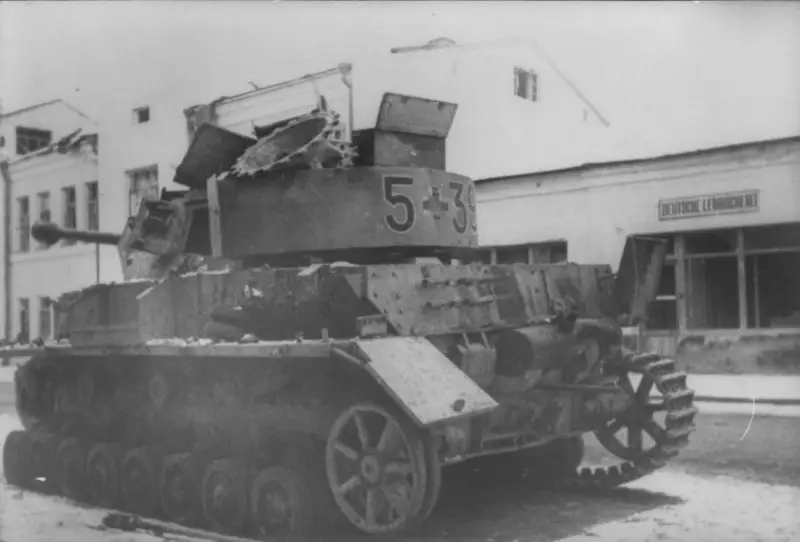
Defective German medium tank Pz. Kpwf. IV Ausf. H, abandoned on the street of Zhitomir. The machine is dismantled for spare parts.
Battle for Zhitomir, Bila Tserkva and Berdichev
The Red Army developed its first success. The Germans had a strong group in the Zhitomir region - parts of two tank, 3 infantry and security divisions, and planned to stop the movement of our troops with a stubborn defense of this city. Therefore, it was not possible to take the city on the move.
To prevent the battle from prolonging, the front command decided to defeat the enemy’s Zhytomyr group with simultaneous attacks from the front and flanks. Units of the 60th Army bypassed the city from the north-west, cutting off communications Zhitomir - Novograd-Volynsky. Poluboyarov's 4th Guards Tank Corps made its way to the Vysoka Pech area, intercepting the road that led from Zhitomir to the west.
At the same time, troops of the 18th Combined Arms and 3rd Guards Tank Armies bypassed Zhitomir from the southeast, intercepting the Zhitomir-Berdichev railway. Troops of the 1st Guards Army attacked the city from the east. As a result, in order not to be surrounded, the Zhytomyr enemy group left the city and retreated. On December 31, our troops liberated Zhitomir. In honor of the liberation of the city, a 224-gun salute was fired in Moscow.
On January 3, 1944, units of the 13th Army liberated Novograd-Volynsky. German troops offered fierce resistance in the Berdichev area, where the Germans had units of two tank divisions. Units of the Soviet 1st Tank and 18th armies tried to take Berdichev on the move at the end of December, but the assault failed. The advanced units of the 44th Guards Tank Brigade under Lieutenant Colonel I. Gusakovsky, part of the 11th Guards Tank Corps, broke through into the city and were surrounded. The tankers took up a perimeter defense and were forced to fight in isolation from the main forces.
The deputy brigade commander for political affairs, Major P. P. Getman, reported:
Only after 5 days of fierce fighting did our troops break through the enemy’s defenses and liberate Berdichev on January 5th.
No less fierce battles took place for the White Church.
For four days, the troops of the 40th Army attacked enemy positions and repelled his counterattacks. On January 4, Soviet soldiers liberated Bila Tserkva. On January 27, the left-flank 7th Army liberated the city of Rzhishchev from the Nazis and united with the troops that occupied the Bukrin bridgehead.
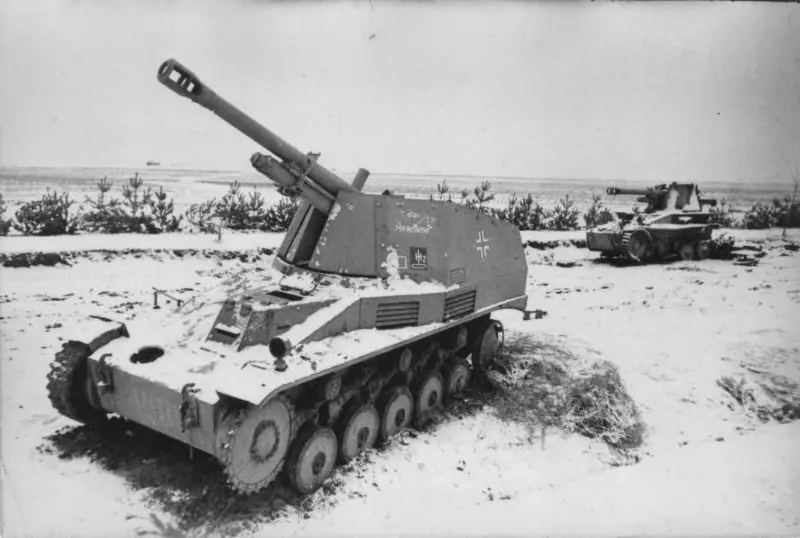
German 105-mm Vespe self-propelled guns (Sd. Kfz. 124 Wespe) knocked out and abandoned west of Zhitomir. The nearby self-propelled gun bore a proper name - “Annelisa”. 1st Ukrainian Front. 1944
Enemy counterattacks
On January 4, 1944, Manstein flew to German Headquarters for a meeting with the Fuhrer. The commander said that if there were no serious reinforcements to support the northern flank of the South group, then soon the entire southern wing of the Eastern Front would be in Romania or thrown into the Black Sea.
The German command, having strengthened its group in the Kiev direction, launched several strong counterattacks against the Soviet troops. The Germans tried to destroy the Soviet troops that had rushed forward, defeat the southern flank of the 1st UV, and strike at the rear of the strike group of the Soviet front. If the operation was successful, the Germans could defeat the entire strike force of the front, restore their previous position in the Kiev direction and build on their success.
By January 10, having concentrated 6 divisions and 2 divisions of assault guns east of Vinnitsa, the Germans attacked the units of the 1st Tank and 38th armies that had moved forward. The troops of the German 1st Tank Army of General G. Hube - 2 tank divisions, a separate tank battalion (it was armed with heavy Tiger tanks), and a division of assault guns struck in the Uman direction. Here, units of the 5th Guards Tank Corps and the 40th Army that broke through to the Khristinovka area were attacked.
As a result, on January 14, 1944, our troops in the Vinnitsa and Uman directions went on the defensive. Fierce fighting ensued here and continued until the end of January. Both sides brought additional forces into the battle, but did not achieve decisive success. German strike groups were able to advance 25–30 kilometers.
However, the Germans were unable to defeat the Soviet troops and restore their previous position. The Wehrmacht suffered serious losses. And the beginning of the offensive of our troops in the Korsun-Shevchenko direction forced the enemy to finally abandon plans to restore the previous situation in the Zhytomyr-Kiev direction.
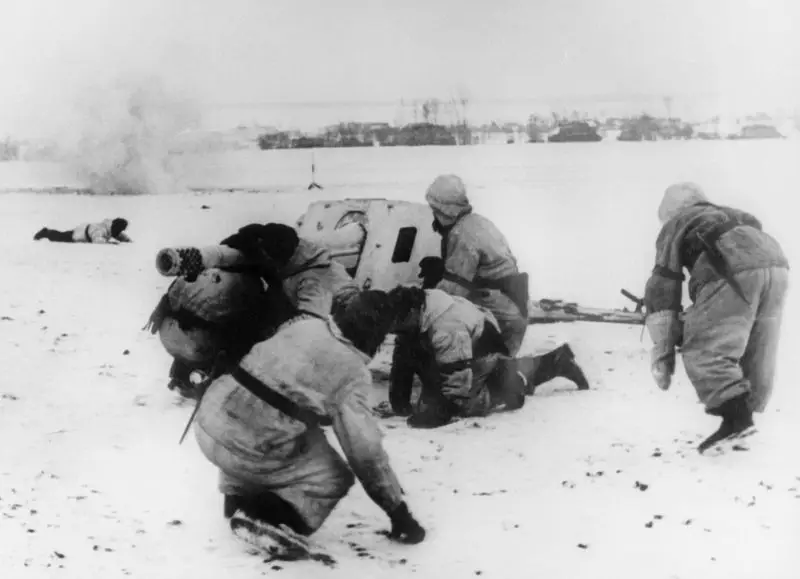
Crew of a German 75-mm anti-tank gun PaK 97/38 (7,5 cm PaK 97/38) under Soviet artillery fire in the Berdichev area. January 1944
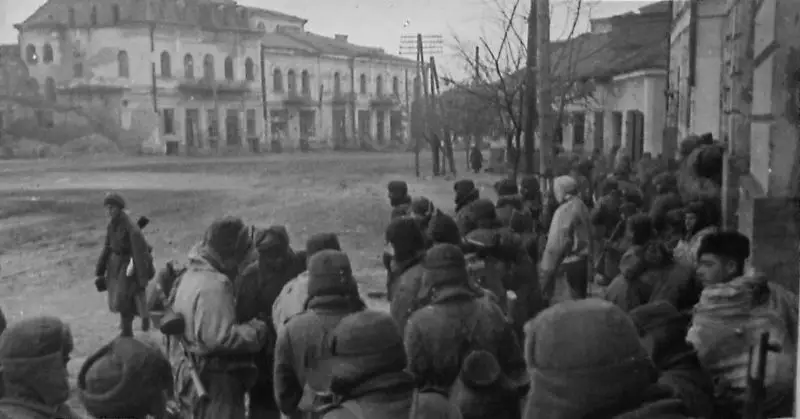
Soviet marines on the street Berdichev. January 1944
Results of the operation
During the Zhitomir-Berdichev operation, Russian troops achieved a major victory. The troops of the 1st UV advanced in a 700 km zone to a depth of 80 to 200 kilometers. The Kiev and Zhitomir regions, part of the Vinnitsa and Rivne regions were almost completely liberated from the Nazis.
Vatutin's armies hung even more from the north over the German Army Group South, and the left wing of the front (27th and 40th armies) deeply engulfed the enemy's Kanev grouping. This created favorable conditions for an offensive in the Korsun-Shevchenkovsky area.
Soviet troops inflicted a heavy defeat on the northern wing of Army Group South - the 4th and 1st Tank Armies. Several German divisions were defeated. A huge gap arose, there was a threat of cutting off Army Group South from Army Group Center and the loss of the main communications that connected the troops of Army Group South with Germany.
The German command had to make enormous efforts to stabilize the front. To do this, 12 divisions were transferred to the Kiev direction from the reserve and quieter sectors of the front. The Germans organized a series of strong counterattacks, were able to push back the advanced forces of the Red Army, stop the Soviet offensive, but could no longer restore the previous position.
Moreover, the German command depleted almost all reserves, which were already small, which affected the course of further hostilities (in favor of the Russians). To repel new Soviet attacks, the Germans had to transfer troops from Western Europe or weaken other directions.
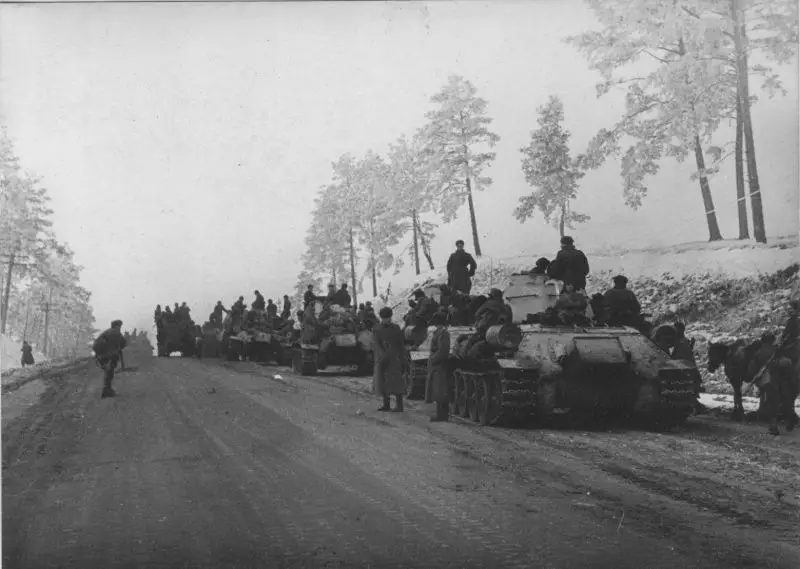
Soviet tank unit with troops on armor on the Zhitomir highway near Kiev
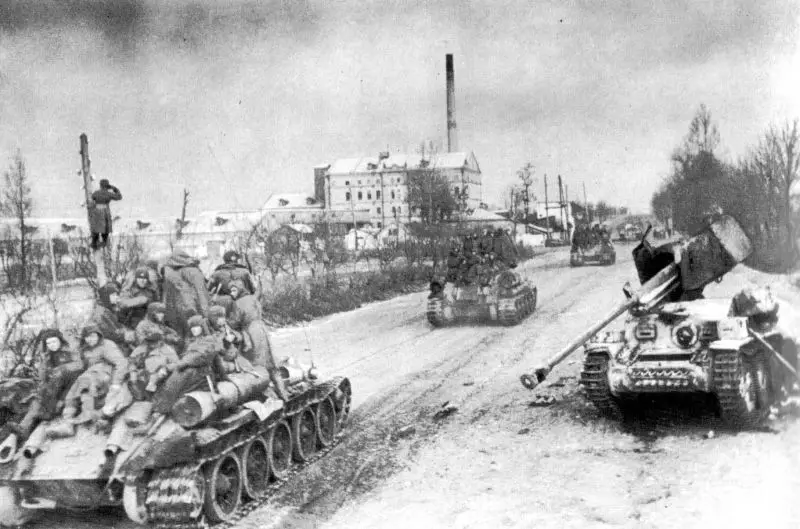
T-34 tanks of the 44th Guards Tank Berdichev Red Banner Brigade with armored infantry drive past a knocked out German self-propelled gun Marder III in liberated Berdichev. In the background you can see Glavmuk Mill No. 19. January 1944
Information